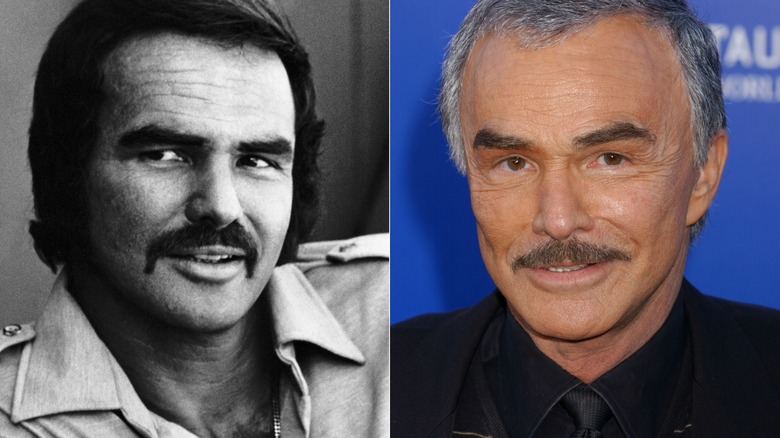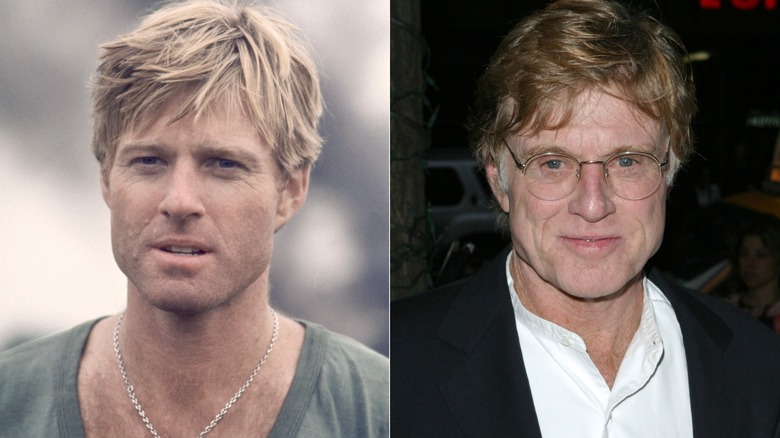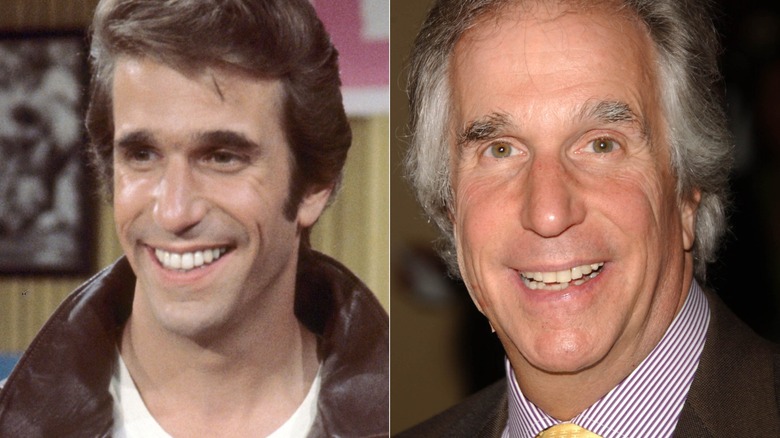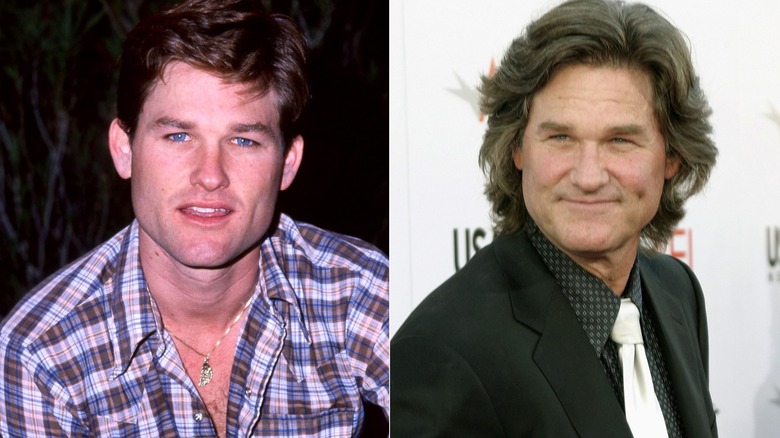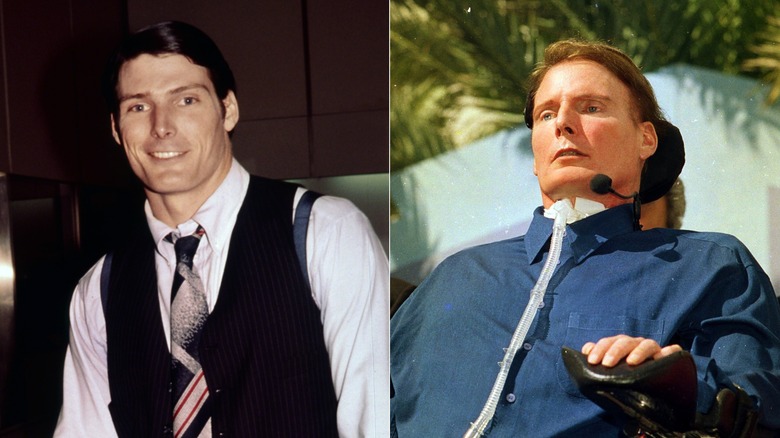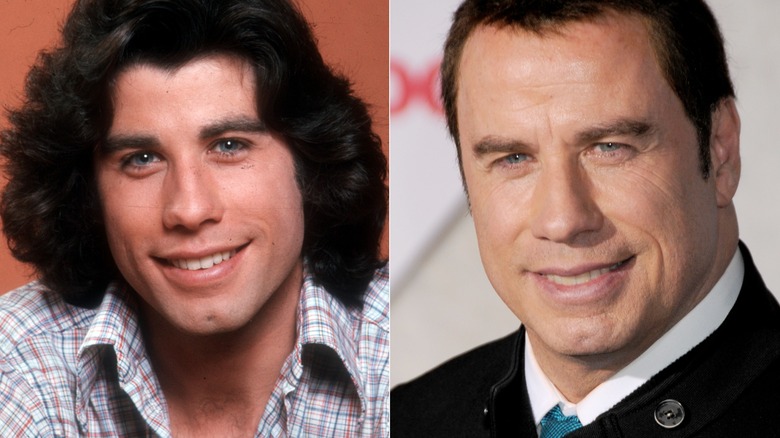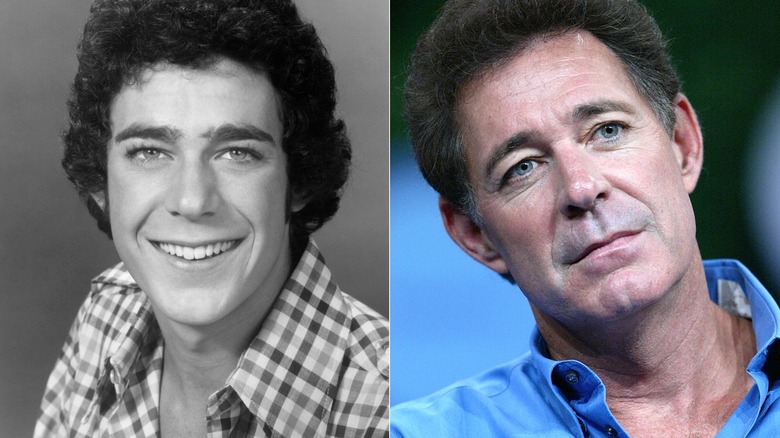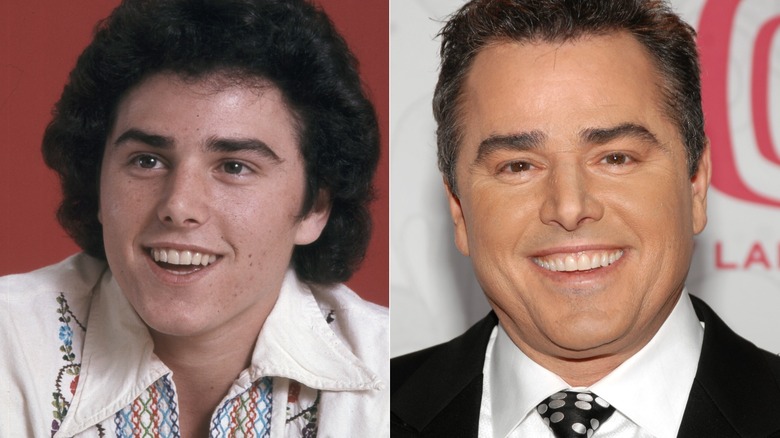'70s Heartthrobs Who Looked So Different In The 2000s
Whether through movies or television shows, the 1970s were a decade that saw a lot of stars rise to the heights of Hollywood. Some of these actors had been working for years and finally got their big break, which launched them to stardom. Others were younger actors who quickly landed major roles in hit projects, changing their lives forever. Regardless of their respective career journeys, it's always enticing to look back at the biggest heartthrobs of the '70s.
The '70s are a fascinating decade to reflect on, but it's just as interesting to see what these stars were up to many years after the public deemed them heartthrobs. Most of the stars on this list remained in the entertainment industry at the turn of the century, but they also changed significantly.
Burt Reynolds starring in a remake of one of his most iconic movies in the 2000s proved just how much he had changed
Burt Reynolds emerged as one of the most talented stars in Hollywood throughout the 1960s. By the time the '70s rolled around, he had fans all over the world fawning over him. Because of his prominent build, Reynolds was perfect for macho man-type roles in movies like "Fuzz," "Deliverance," and "Smokey and the Bandit." Plus, Reynolds usually rocked a moustache in the '70s, which definitely helped his heartthrob status.
In addition to being swooned over by people all around the world, major movie producers and directors sought Reynolds in the '70s. Reportedly, Reynolds turned down playing two of the most popular movie characters of all time: James Bond and Han Solo. Reynolds turned down the chance to play James Bond after Sean Connery stepped away from the role because he didn't believe 007 should be played by an American. Later, in an interview with USA Today, the actor admitted he regretted this decision, saying, "I could've done it and I could've done it well." He also later admitted he regretted not playing Han Solo, but still having the type of career he had despite turning down these roles proves how talented Reynolds truly was.
His most popular movie from the '70s is arguably "The Longest Yard," in which he played an ex-football star who forms a team in prison to compete against the guards. He also appeared in Adam Sandler's remake of "The Longest Yard," which hit theaters in 2005 and proved how much Reynolds had changed. In the 2000s, Reynolds still commanded the screen and even rocked his iconic moustache, but his hair had gone gray, and it was clear a lot of time had passed since his days as a heartthrob.
Robert Redford still looked cool and commanded the screen as he aged
Just like Reynolds, Robert Redford slowly started garnering roles in Hollywood throughout the 1960s. Thanks to the success of 1969's "Butch Cassidy and the Sundance Kid," he had plenty of momentum heading into the '70s, and he definitely took full advantage of it. Throughout the '70s, Redford starred in movies like "The Sting," "The Way We Were," and "All the President's Men." These films and several others cemented him as a major heartthrob in the '70s. With his striking blond hair and pronounced jawline, Redford seemed like an actor who was plucked out of Hollywood's golden age and dropped into one of the most exciting times for cinema.
Even though Redford's acting career slowed down a little bit in the 2000s, he continued to be an influential figure in Hollywood. He shared the screen with younger actors and showed off his expertise in movies like 2001's "Spy Game" and 2005's "An Unfinished Life." At this point in time, Redford was a Hollywood veteran, and he looked the part. In the 2000s, some gray started sneaking into Redford's full head of hair, and he usually sported glasses, which definitely reflected his age.
James Brolin has consistently embraced his facial hair throughout the 2000s
Just like Reynolds and Redford, James Brolin also experienced immense success as a leading man in the 1970s. He starred in movies like "Skyjacked," "Westworld," and "The Amityville Horror." Throughout this decade, Brolin stole scenes in movies with his piercing stare, thick head of hair, and sometimes even a bushy beard, which helped to complete his rugged look.
His heartthrob status throughout the '70s led to him being offered the role of James Bond for 1983's "Octopussy" when Roger Moore wanted to bow out. Unlike Reynolds, Brolin accepted the role and was excited to play the iconic British spy. In an interview with People, he said, "He [Moore] was out, so I flew over and I met all the people. And I got my apartment and I started working with the stuntmen and Cubby Broccoli hired me." However, Moore ended up changing his mind and decided to reprise his role as 007, which means Brolin never got the chance to play the character.
This setback didn't stop Brolin's momentum, though. He continued to have a successful career in Hollywood and eventually married Barbra Streisand in 1998. In the 2000s, Brolin and Streisand both glowed as they consistently walked red carpets together. At this point in time, Brolin's hair and beard were both gray, and he often wore glasses. He definitely looked much different than he did in the '70s, but it can't be denied that he has aged gracefully.
Harrison Ford changed a lot, but still revisited an iconic character in the 2000s
Reynolds turning down the role of Han Solo was great news for Harrison Ford. After previously working with George Lucas on 1973's "American Graffiti," Ford landed the role of the smooth-talking and overconfident smuggler in "Star Wars." The 1980s may have been a more successful decade for Ford since it saw the release of "Blade Runner" and the first three "Indiana Jones" movies, but "Star Wars" still established him as a heartthrob in the late '70s. In this decade, Ford managed to steal hearts with his all-American look and ultra-cool swagger, which allowed him to always steal scenes in films.
The success of "Star Wars" gave Ford an incredible amount of momentum moving forward in his career, and the actor never took his foot off the gas. After becoming one of the biggest movie stars in the world in the '80s and '90s, Ford continued to dominate Hollywood in the 2000s. He starred in 2000's "What Lies Beneath," 2006's "Firewall," and most prominently reprised one of his most iconic roles in 2008's "Indiana Jones and the Kingdom of the Crystal Skull."
Even though reviews for the fourth "Indiana Jones" movie were somewhat mixed, Ford proved that he still had all the qualities that made him a star in the '70s. He may have had some more gray in his hair in the 2000s, which took away his boyish charm, but in "Indiana Jones and the Kingdom of the Crystal Skull" and several other movies, Ford still had the same charisma as earlier in his career.
Henry Winkler no longer rocks The Fonz's greasy look from Happy Days
The previous four actors on this list were all major movie stars, but Henry Winkler instead commanded the small screen in the 1970s. Winkler starred as Arthur Fonzarelli, better known as "The Fonz," in every season of "Happy Days," which ran from 1974 to 1984. "Happy Days" was a major success, and "The Fonz" was always a fan-favorite character. In the show, Winkler sported combed-over black hair and "The Fonz's" signature leather jacket, which made him look like a stereotypical 1950s greaser.
After Winkler's time on "Happy Days," he still experienced success in Hollywood. He starred in a variety of movies and shows in the '80s and '90s, but by the time the 2000s rolled around, it was clear that so much had changed since "The Fonz" strutted around on television screens all across America. In the 2000s, Winkler still had the same charm he had as a younger actor, but his hair had turned gray, which made him look nearly unrecognizable from his time on "Happy Days."
David Cassidy ditched his '70s style but still had his charming smile in the 2000s
Staying on the topic of major shows from the 1970s, David Cassidy was a talented singer and musician who starred on "The Partridge Family" and passed away in 2017. This show aired from 1970 to 1974 and ensured that Cassidy was one of the most prominent teen idols of the '70s. During his time on "The Partridge Family," he had a charming smile, radiant eyes, and a classic '70s hairstyle that flowed down to his shoulders. This look and his musical talent ensured he had droves of fans who loved to swoon over him.
Cassidy looked back on his time on "The Partridge Family" in an interview with NJ.com in 2011, saying, "It was fascinating how quickly it evolved, just by fate. It was obviously God's intent. I feel very, very fortunate to have had all of the stars align to do that. Because I was able to not only become very successful but to touch people's lives and bring light into their lives." In the years after the series ended, Cassidy continued to find immense success as a singer and even dabbled in acting, which proved he was a force to be reckoned with in the entertainment industry.
Heading into the 2000s, the former teen idol continued releasing music and performing all over the world. In the 2000s, Cassidy still had striking eyes and a pleasant smile, but his hairstyle made him nearly unrecognizable. Eventually, Cassidy changed with the times and got rid of his longer '70s hairstyle, opting for a shorter, more traditional look.
Mark Hamill has changed a lot since playing the most iconic Star Wars character
Just like the aforementioned Ford, Mark Hamill became a major heartthrob in the late '70s thanks to the release of "Star Wars." The influential sci-fi movie was Hamill's debut on the big screen. From the moment Luke Skywalker gazed upon the setting binary suns on Tatooine, it was clear Hamill had perfect movie star looks. The success of "Star Wars" obviously skyrocketed his fame and saw him receive a lot of public attention in the late '70s. However, unlike Ford, Hamill didn't necessarily establish himself as one of the biggest actors in the world moving forward.
In fact, other than the release of the two "Star Wars" sequels in the '80s, it seemed like Hamill struggled to hit it big with a movie and find a path in Hollywood that wasn't connected to the sci-fi franchise. For a time, it seemed like Hamill became a "Star Wars" actor who disappeared from Hollywood. Eventually, he chose to focus on animation, and by the time the 2000s rolled around, he had established himself as an incredibly talented voice actor. Most prominently, Hamill voiced The Joker in "Batman: The Animated Series" and several other DC projects.
Possibly because he was primarily focusing on voice acting, an older and more mature Hamill didn't have the typical movie star looks in the 2000s. When the Luke Skywalker actor made public appearances in the 2000s, it was clear he had long abandoned his blond bangs and allowed himself to age naturally, which meant some distinctive wrinkles started showing up on his face.
Kurt Russell has become a Hollywood veteran since stealing hearts in the '70s
Kurt Russell started working as an actor at a young age and landed roles in various movies and shows in the 1960s. In 1966, he signed a ten-year contract with Walt Disney Productions and, according to film historian Robert Osborne, became the "studio's top star of the '70s." Throughout this decade, he starred in films like "The Barefoot Executive," "Fools' Parade," and "Now You See Him, Now You Don't." Russell's youthful energy, blue eyes, and, in some projects, his flowing blond hair, made him a heartthrob in the '70s.
Following Russell's time working for Disney as a young actor, his success in Hollywood continued, and he became one of the most accomplished movie stars in the world. Throughout his career, he has starred in movies like "Escape from New York," "The Thing," "Tombstone," and "Death Proof." In a lot of his most famous roles, Russell has played characters that are a bit rough around the edges, and his looks throughout the years reflect that. By the time the 2000s rolled around, Russell's graying hair and wrinkles proved that a lot had changed since he was a young actor working for Disney.
A tragic accident changed Christopher Reeve's life years after he debuted as Superman in the '70s
Christopher Reeve instantly became a major heartthrob in the late '70s when he was cast as Clark Kent/Superman. The first Superman movie hit theaters in 1978 and turned Reeve into one of the biggest movie stars in the world. At the time, Reeve was a tall, muscular, all-American young man with curly black hair and a striking smile. He continued to play the Man of Steel in the '80s and appeared in many other movies and shows throughout his career, as well. Unfortunately, tragedy struck Reeve in 1995 when a horse riding accident left him paralyzed from the neck down.
After this accident, Reeve was confined to a wheelchair for the rest of his life. Due to his severe injuries and the trauma he faced, he even contemplated suicide, but instead decided to dedicate his life to becoming an advocate for spinal cord injury research and treatment. In 1999, the Christopher Reeve Foundation (now the Christopher and Dana Reeve Foundation) was formed. In the years following his accident up until his death, Reeve and his wife, Dana, worked hard to bring awareness to and raise funding for those struggling with spinal cord injuries. Unfortunately, Reeve passed away in 2004 due to heart failure, which was caused by an infection.
John Travolta has experimented with many different looks in the 2000s
Starring in movies like "Saturday Night Fever" and "Grease" turned John Travolta into one of the biggest movie stars of the 1970s. Heading towards the end of the '70s, audiences couldn't get enough of Travolta and his flowing black hair. Speaking with Daily Commercial, Travolta looked back on "Saturday Night Fever," which solidified him as a heartthrob, and said, "I think it was the blueprint for everything that has happened to me. It put me on the map."
After his major hits in the late '70s, Travolta has remained one of Hollywood's biggest actors throughout his entire career by starring in movies like "Look Who's Talking," "Pulp Fiction," and "Face/Off." However, by the time the 2000s rolled around, it was clear a lot had changed since the actor earned his heartthrob status. As he grew older, Travolta resorted to sporting much shorter hair and was even spotted with a soul patch at several public appearances in the 2000s, which is definitely one of the riskiest facial hair styles a man can try to pull off.
A lot has changed since Barry Williams was the oldest sibling on The Brady Bunch
A conversation about 1970s heartthrobs can't be had without mentioning some of the brothers from "The Brady Bunch," one of the most popular shows of the decade. Firstly, Barry Williams became a heartthrob the moment he appeared onscreen as Greg Brady, the oldest sibling in the series. Williams played this character during the show's original run from 1969 to 1974 and has consistently reprised the role for spinoffs and sequels throughout his career. According to an interview Williams did with People, Greg Brady's personality is very similar to his own. The actor said, "It was impossible to juggle the two identities, so I just combined them. And the truth is, there's not that much difference."
Based on the above quote, it's clear that Williams has a deep connection to his character from "The Brady Bunch." Viewers felt a connection to Greg Brady as well, and swooned over him as they watched him lead one of television's most lovable families. Williams' long brown hair, thick eyebrows, and chiseled jawline helped make him an icon of the '70s. However, even though the actor was still largely associated with "The Brady Bunch" by the time the 2000s rolled around, it was clear a lot had changed. In the 2000s, Williams sported shorter hair that was starting to thin, and his age was beginning to show.
Christopher Knight has ditched the long hairstyle that he rocked on The Brady Bunch in the '70s
Even though he played a younger sibling on "The Brady Bunch," Christopher Knight was also an icon of the 1970s. Knight played Peter Brady in the original series and, just like Williams, appeared in many movies and shows that were set after the events of "The Brady Bunch." Peter Brady's somewhat dorky nature on the show made many viewers resonate with him. Because of this, Knight amassed a large fanbase throughout the '70s. However, in an iHeart Radio podcast, Knight admitted that he was relieved when "The Brady Bunch" ended since he hadn't decided whether he actually wanted to be an actor yet. "I wanted to go to school," he said. "It wasn't my idea to be an actor ... I hadn't decided on what I wanted to do with my life."
While he appeared in several other projects related to "The Brady Bunch," Knight switched careers in the late '80s and joined the computer industry. His first job was as an account sales manager for Martec, Inc., and he actually landed the company's first million-dollar sale. Despite his success in the computer industry, Knight still made public appearances in the 2000s and appeared in several movies and shows. Obviously, he was no longer the innocent-looking middle child of "The Brady Bunch" family. Instead, Knight looked like a true business professional with a short haircut, proving that much had changed since his time as a child star.


